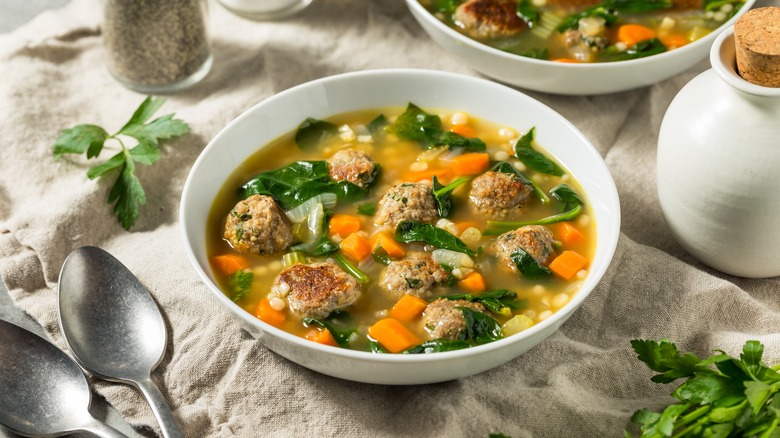Italian Wedding Soup's Name Has A Different Meaning Than You May Think
Some people think of soup season as being in the colder months, but this hearty, delicious dish can certainly be enjoyed any time of year. Homemade soup is often slow-simmered to let the flavors blend together nicely, and that's actually the reason Italian wedding soup is called what it is. While it's not unusual to see this soup served at Italian weddings, its name doesn't actually have anything to do with the time and place.
Similarly to how weddings bring two people together, Italian wedding soup brings a number of flavorful ingredients together — in a "marriage," if you will. The soup's origin story begins with the Italian phrase "minestra maritata," which translates to "married soup." The soup blends ingredients with distinct flavors, such as bitter greens and rich meats, which come together to create a profile that can only be reached with the proper amount of cooking time. Italian wedding soup in the United States differs slightly from the traditional Italian version, though.
Italian wedding soup differs between the U.S. and Italy
While the meaning behind the soup's name remains the same, there are actually some key differences between Italian-American wedding soup and the traditional Italian recipe. In Italy, different types of meat are used, but meatballs are never used. Rather, anything from chicken to pork, such as pancetta prosciutto, are paired up with slightly bitter greens, including escarole and chard, and all of the flavors are softened and blend as they cook. The soup is enhanced with acini de pepe pasta for added flavor and texture.
In the U.S., though, homemade meatballs are usually the meat of choice. While escarole is still common in U.S. versions of the soup, other more accessible greens, such as fresh spinach leaves, are sometimes used instead. And acini de pepe isn't always easy to find in most grocery stores, so any kind of small pasta, such as orzo or ditalini, is frequently substituted. Pearl couscous can be used, too. Although there have been some changes made between the two soup variations, the styles and cooking process of marrying everything together remains the same.

